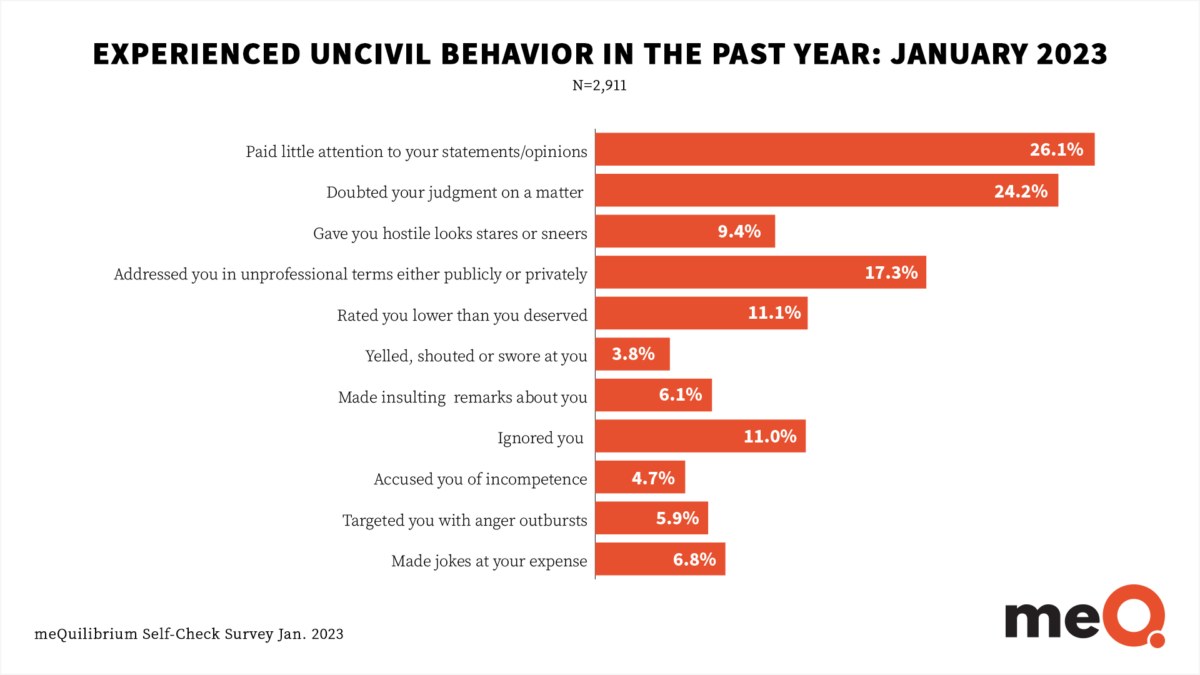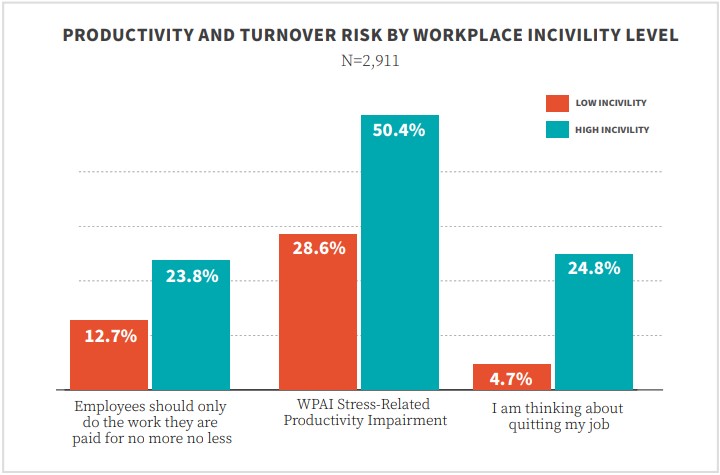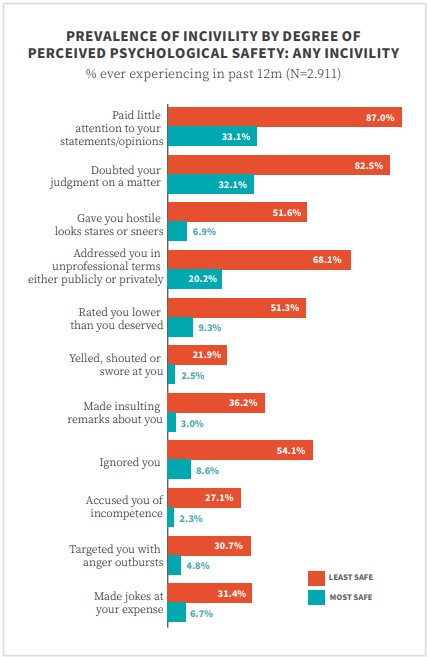What is LIDBAIHT and why should you care?
Since the pandemic, new sources of stress such as layoffs and economic uncertainty have emerged. Our latest report looks at workplace incivility and other current trends impacting employee well-being.
Since the pandemic, new sources of stress such as layoffs and economic uncertainty have emerged. Our latest report looks at workplace incivility and other current trends impacting employee well-being.
LIDBAIHT stands for “low-intensity deviant behavior with ambiguous intent to harm the target.” That’s how wikipedia–rather academically–describes workplace incivility. Many of us have experienced it more viscerally than the definition suggests. For me, it’s how I feel when the jerk over in analytics (or finance, or wherever) talks over me in a meeting, subtly questions my competence in front of the team, or gives me a nasty look in passing in the hallway. And it’s on the rise.
The rate of social and political upheaval in the U.S., accelerated in part by the pandemic, has created a situation that puts people on the defensive. Well over half (64%) of people feel that their rights are under attack. Deepening economic uncertainty over job security and inflation has only accelerated this negative trend. Given the context, it’s unsurprising that, as many workers return to their normal work sites, incivility is reportedly on the rise, due in no small part to workers being out of practice when it comes to dealing with their fellow co-workers in person.
Workplace incivility has deeply negative impacts on both employees and the organization as a whole. When employees are subjected to rude, disrespectful, or aggressive behavior in the workplace, it can lead to decreased job satisfaction, increased stress, and decreased productivity. This can ultimately lead to higher rates of absenteeism and turnover, and decreased organizational performance. Additionally, workplace incivility can create a toxic work environment that undermines team cohesion and collaboration, erodes trust between employees and their managers, and can ultimately damage the organization’s reputation.
We checked in with meQ members early in 2023 in the latest installment of our Self Check series where we’ve been looking in on wellbeing trends, and investigating some special topics along the way, including uncivil behavior in the workplace.
Here are three notable takeaways from the January 2023 report.
Workplace incivility is distressingly common. Uncivil behaviors such as coworkers addressing colleagues in an unprofessional manner, being ignored, or having one’s judgment questioned were relatively common.

As many as 1 in 4 employees in our sample reported one of these experiences on the job. While relatively fewer employees experienced more severe forms of workplace incivility, the prevalence of extreme events is disturbingly common: about 1 in 20 employees reported being targeted with angry outbursts, being yelled at, being accused of incompetence, or being the butt of jokes from coworkers.
 Your CFO should care about workplace incivility. Besides doubling the risk of demotivation and tripling the risk of burnout, uncivil behavior in the workplace impacts bottom-line outcomes like productivity and turnover risk. We saw 2 times the risk of an employee endorsing “quiet quitting,” 2X the degree of productivity impairment and 5X the turnover risk in high incivility environments compared to low incivility environments.
Your CFO should care about workplace incivility. Besides doubling the risk of demotivation and tripling the risk of burnout, uncivil behavior in the workplace impacts bottom-line outcomes like productivity and turnover risk. We saw 2 times the risk of an employee endorsing “quiet quitting,” 2X the degree of productivity impairment and 5X the turnover risk in high incivility environments compared to low incivility environments.
 As usual, it’s about the managers. Our data show that protecting against incivility is not that hard with the right managers. When managers are looking out for psychological safety on the team, the risk of incivility and its concomitant costs are dramatically reduced.
As usual, it’s about the managers. Our data show that protecting against incivility is not that hard with the right managers. When managers are looking out for psychological safety on the team, the risk of incivility and its concomitant costs are dramatically reduced.
We asked respondents whether their direct manager offered support for their mental well-being. The perception of positive support from one’s manager substantially reduced the risk that employees experience uncivil behavior at work. Across 11 different types of uncivil behavior, the presence of a wellbeing-aware manager lowered the risk of incivility by 25 to 66% across the 11 indicators of uncivil behavior.
The impact of psychological safety on incivility risk was yet more dramatic. When we compared environments where psychological safety was low to those where it was high, the risk of incivility was lowered by as much as 90%.
So that’s the “what” and the “so what.” What about the “now what?” We’re already asking for a lot from our managers. How can we ask them to add more to what is already a challenging balancing act? Especially since managers already show elevated burnout and retention risk compared to their team members.
The good news is that resilience helps your managers maintain their own well-being and lead their teams more effectively, and that building workforce resilience can be done scalably, sanely, and sustainably.
Get the full report: The Pivotal Role of Managers in Employee Well-being, Productivity, and Retention: A 2023 meQ Member Research Report

For more than 15 years, Dr. Brad Smith has been telling stories using health data. His career includes roles ranging from policy-focused work with the US Government Accountability Office to evaluation -related work for dozens of state, federal and private sector clients using health services research methods. He currently serves as Chief Science Officer at meQuilibrium, leading efforts to harness data to improve the product, enhance reporting to clients and establish the value proposition. He has served on the faculty of Drexel University and McDaniel College and is the author of more than 25 peer - reviewed articles on health and well-being.